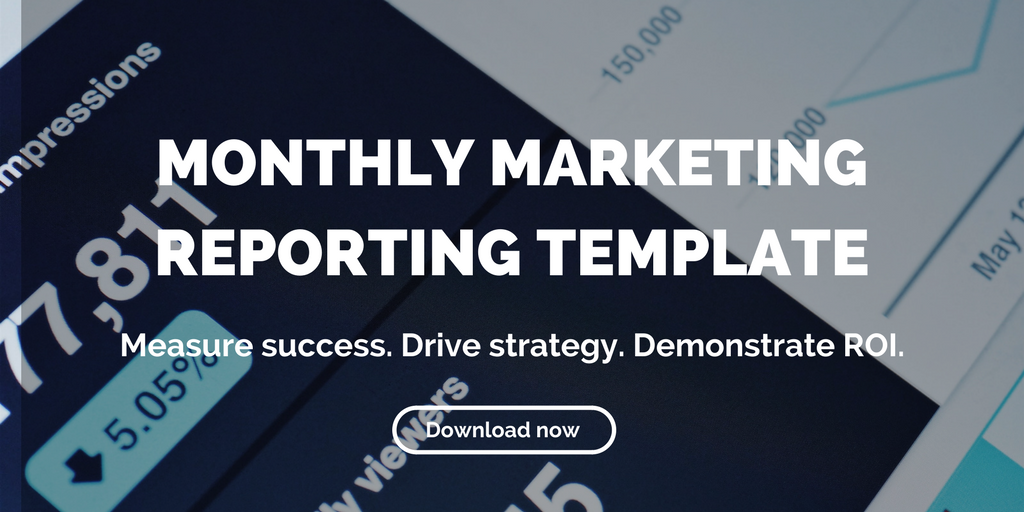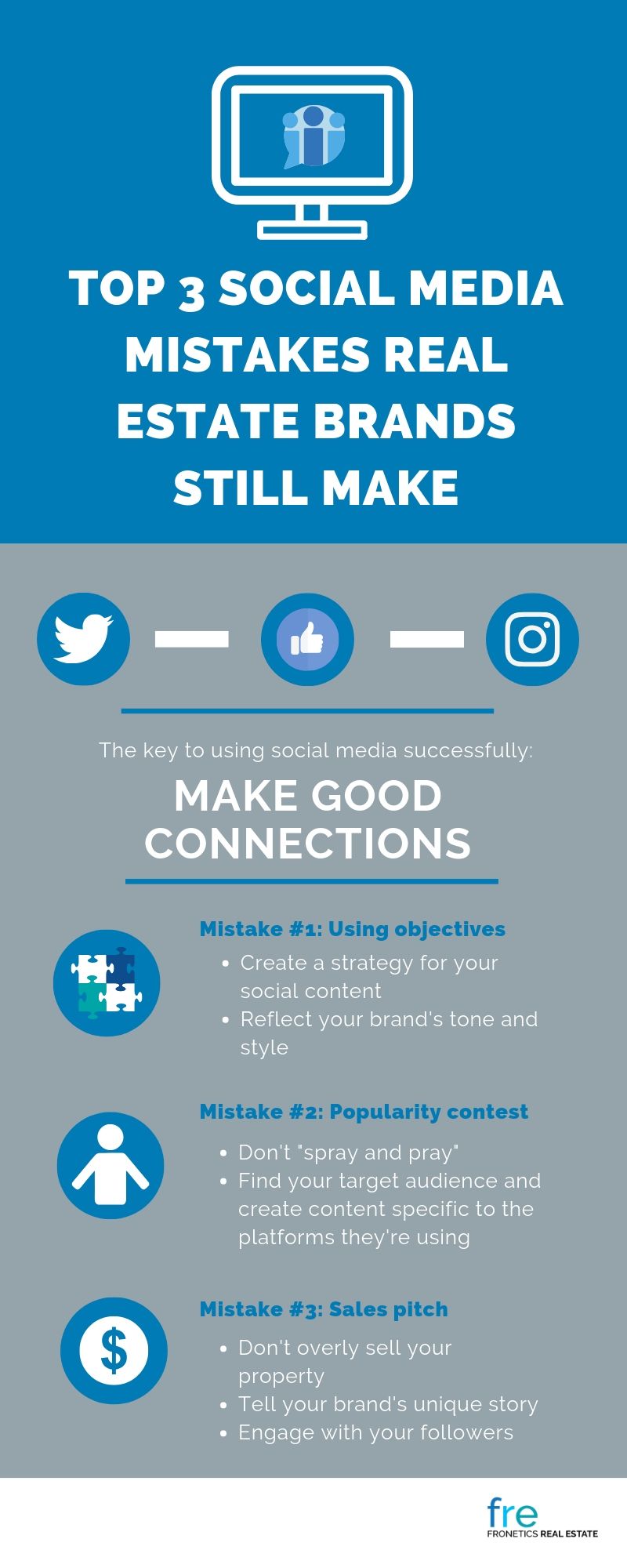Archive for the "Blog" Category

Top Real Estate Marketing Trends 2019
Here are the top real estate marketing trends for 2019, including video, personalized content, and authenticity.
Highlights:
- The popularity of video is still on the rise. Part of what makes video such an appealing form of content is its shareability, which drives organic traffic.
- Marketers should use social media platforms to engage with followers through compelling content.
- Foster creativity in your content through benchmarking and researching competitors.
It’s the start of a new year, and that means savvy marketers are looking to stay ahead of the curve. These top real estate marketing trends are what we see coming for 2019.
1) It’s all about the video
We can’t stress it enough: video is here to stay, and it’s time your business starts embracing it.
Part of what makes video such an appealing form of content is its shareability, which drives organic traffic. Creating appealing, engaging video is an ideal way to make your target audience material to share with their network, with the potential to expand your reach exponentially.
2) Social media users are craving authenticity
Let your social media platforms be places where you engage your followers through compelling content that says something about the culture of your business and your passion for real estate.
3) Keep it personal
Much as users are seeking authenticity from marketing on social media, your potential clients will respond all the better to personalized content and relationship-building. Whenever you can, add a personal touch to your communication with your audience.
4) Get creative
One thing we can say for certain about the new year, and the future of real estate marketing going forward, is that creativity is going to be key. Being aware of trends, benchmarking your marketing efforts against those of your competitors, reading industry blogs, and listening to your client-base are just a few key ways to foster creativity.
To learn more, visit us at froneticsrealestate.com
Related posts:
- Infographic: Real Estate Marketing Trends 2018
- 6 Signs It’s Time to Consider Outsourcing Your Real Estate Marketing
- A Visual Guide to Social Media Posting Frequency for Real Estate
Archive for the "Blog" Category

PPC 101: The Basics of Pay-Per-Click Advertising
Discover the power of PPC marketing and how it can be used to get in front of more people without spending a fortune on leads.
Highlights:
- PPC means that you’re not going to spend a fortune to get your luxury property in front of potential renters and buyers.
- PPC allows you to customize the cost of what you spend per click based on the size of the ad, the prominence on the site, and how popular the website is.
- You’ll spend less per lead using PPC marketing, which is why it is one of the more popular paid marketing plans available.
PPC marketing has been around for a while. Whether you know a little or a lot, we’re here to tell you more. If you’ve thought about using PPC to market your business, we’re here to help.
Let’s start by learning what PPC is and get a basic understanding of how this form of advertising can work for you.
What is PPC?
PPC stands for pay-per-click. It means that you’re not going to spend a fortune to get your luxury development in front of potential renters and buyers. Instead, you’re only going to pay for the clicks that are actually made to your landing page.
When you’re trying to figure out what type of marketing you want to use, PPC works because it’s paid. It ensures that you reach people who you wouldn’t ordinarily see your brand. Particularly when you’re tapping into a new niche, it can be beneficial to spend money because it will make it possible to get the leads that you need.
When it comes to gaining marketing leads, there are several forms of marketing that can be beneficial. This includes a great-looking website, social media, and paid advertising, which should include PPC.
How does PPC work?
PPC is so much more than paying to have your ad on a particular website. You don’t want to spend thousands of dollars to put your ad on a website only for it to sit there without traffic. PPC allows you to customize the cost of what you spend per click based on the size of the ad, the prominence on the site, and how popular the website is.
There are different types of PPC, such as search ads and display ads. This determines where your ad is going to go. A variety of ad networks will make it easy for you to find a home for your ads. Google Ads is one of the most popular ones that you can use. Bing and Microsoft have their own versions, too. With display ads, you’re able to choose the graphics as well as where the ad leads to, whether it’s a homepage or a specific landing page.
You only pay when someone clicks on the ad. If your ad is shown to 1,000 people and only 10 people click on it, the only expense is the cost of 10 clicks. This ensures that the overall marketing cost is lower. You’ll spend less per lead using PPC marketing, which is why it is one of the more popular paid marketing plans available.
Particularly within the luxury development industry, the cost per lead is going to be a little higher while still allowing you to get a great return on investment. Some keywords will cost more than others. Further, where the keywords are being placed can cost more.
A budget can be created to stay in control of what you spend. The cost is usually identified as per day or per month. Once you have reached your allotted budget for the timeframe, the ad network will turn your ads off so that no more money is spent.
Related posts:
- Paid Social Advertising: Why Your Property Should Invest in Lead Ads
- How Pay-Per-Click Helped This Property Get 54 Leads
- Paid Digital Advertising: A Beginner’s Guide for Real Estate Marketers
Archive for the "Blog" Category

Top 6 Effective Digital Marketing Strategies For 2019
As a real estate marketer, you want to be at a competitive advantage. To sell properties faster, here are six digital marketing strategies to get your properties in front of your competitors.
When it comes to real estate marketing, the same concepts apply. Everybody wants to know what the competition is doing differently. To drive sales, you have to look at your performance and make changes where necessary.
The trick is to look at key performance indicators (KPIs) such as website traffic, conversion rate, market share growth, purchaser rate, and social media engagement as benchmarks to measure your progress. But there is more to real estate digital marketing than just looking at your website traffic.
Here are six of the top digital approaches that work for real estate.
1. Optimize your website
As of July 2019, there are 4.33 billion active internet users, most of whom come from the United States. This means almost everyone, including those searching for luxury developments, is using the internet to do research and find properties to purchase. Therefore, the importance of having a professional website cannot be emphasized enough. In fact, many luxury real estate firms are using digital media to show their properties online.
Recent data from the National Association of Realtors backs this up:
- 90% of real estate firms have websites to show their property listings.
- Over 50% of home buyers looked online for properties in 2018
With the traditional real estate market increasing its online presence, optimizing your website is crucial to get ahead of the competition and reach more potential buyers. The result? More sales.
2. Be easy to reach
With a professional and well-optimized website, users will want to reach you. Make sure you include all your contacts on social media pages, website, and emails. Your contact information should remain consistent whether it’s on a business card or social media accounts — you’d be surprised how often this is not the case!
3. Have a video marketing campaign
Of all the digital formats, videos have the highest engagement rate, making video marketing one of the most effective digital marketing strategies to showcase your services, increase brand awareness, and lower cost per lead.
Videos on Twitter get an average of more than six retweets, while Facebook users view 100 million hours of video content daily. Video content can drive organic search traffic by 157%.
4. Start blogging
Do you want more prospective visitors to your website? Then start a blog or breathe new life into that dormant one on your site. A business blog is an essential and inexpensive marketing tool for driving traffic to your web pages and improving search engine ranking.
However, did you know only 44% of people update their blogs, yet there are over 329 million monthly readers? So, while other companies are relying on traditional marketing strategies, you can capitalize on this competitive advantage and use a blog to provide value to customers and build trust.
5. Use social media as part of your digital marketing strategy
You need to be where your prospects are. That means you need to build a strong presence on social media platforms like LinkedIn, Twitter, Facebook, Instagram, WhatsApp, and many others. The easiest way to promote your brand is to through your social media account. According to Forbes, having a LinkedIn company page increases brand awareness and helps to promote your services to potential clients. With over 500 million users, LinkedIn is also the most effective social media platform for securing professional audience engagement. You can also use all the other social media accounts to communicate with your followers and boost your online presence directly.
6. Optimize for local SEO
Even after optimizing your website to reach a broad audience, you should also focus on local traffic. A targeted approach allows those looking for properties nearby — let’s say in Boston or surrounding areas — to get the luxury development listings that match their needs and goals. Use Google Analytics to find out if locals are visiting your site and add your company to local directories. Other ways to optimize for local SEO is to use a local number, encourage customers to leave reviews, and having geo-targeted content.
As of 2019, there are more options to market real estate business than ever. Whichever digital marketing strategy you prefer, you should be branching out and using the most effective ones for your business. Remember, your real estate digital marketing goals should be tailored to maximize your visibility online, bring in new businesses, and keep you ahead of the competition.
Related posts:
- Real Estate Marketing Leads: 4 Myths (and How to Disprove Them)
- DIY Digital Marketing Strategy for Real Estate in Four Easy Steps
- Developing Your Real Estate Brand with Video Marketing
Archive for the "Blog" Category

Infographic: Top 3 Social Media Mistakes Real Estate Brands Still Make
Social media is a valuable tool for real estate brands, but only if they use it to their best advantage and avoid these three common mistakes.
Highlights:
- Social media is one of the most effective ways to increase brand awareness and generate leads.
- All social media channels have a differentiating quality that makes them appealing to specific audiences. Don’t try to tackle every platform, focus on where your target audience is spending time.
- Real estate brands that succeed on social media are finding innovative and creative ways to engage and connect with their users.
91% of real estate professionals use social media. And we all understand why. By 2019, it is estimated that there will be around 2.77 billion social media users around the globe. That’s a lot of potential customers.
So it’s easy to understand why real estate brands are using social channels to boost their marketing efforts. Social media is an easy and effective way to increase your properties visibility and reach new audiences, but only if you use it correctly.
Top three social media mistakes real estate brands make
Mistake #1: Using objectives
Marketers need to use strategy to effectively utilize social channels. With the constant updates and changes to social platforms, real estate brands need to plan out content, frequency of posts, and pillar topics. Instead of posting with objectives in mind — like increasing leads — try to create posts that reflect your brand, follow your style guidelines, and reflect your brand’s tone.
A clear strategy can also help improve ROI. Almost two-thirds of marketers still struggle to prove their marketing efforts on social platforms are working. With a defined social media strategy, you can create specific goals, track and measure your efforts, and make changes when needed.
Mistake #2: Popularity contest
It’s easy to think that posting on all the most popular social channels is the best idea. Think again. Social media platforms have specific qualities that make them popular among audiences. Real estate marketers need to identify their target audience and find out what social channels they are using.
The next step is to create content that aligns with those platforms. As marketers, we know how easy it is to post the same content across all platforms. The success behind social media is authenticity and engagement, so it’s important your posts reflect this. Create content, like video, that caters to social channels to help build brand awareness and loyalty.
Mistake #3: Sales pitch
Being overly “salesy” will make prospects run – maybe right into your competition. The best way to win buyers on social media is through engagement. Content that helps prospective buyers envision themselves in your property is what will increase your organic reach. Create innovative and informative content that stands out on social channels by telling your brand’s story. This unique perspective will help create an emotional connection will have a long-lasting impact on viewers and drive brand loyalty.
Related posts:
- 5 Creative Ways to Use Instagram Stories for your Luxury Real Estate Brand
- Measure Social Media Success in Terms of Potential, not Dollar Amount
- How to Use Social Media Hashtags in Real Estate Marketing
Archive for the "Blog" Category

Get Personal: the Human Side of Real Estate Marketing
Using emotion in your real estate marketing to appeal to buyers can help you sell homes more easily and effectively.
Highlights:
- Emotions often strongly influence buying decisions when the time comes to purchase a property.
- There’s a big difference between listing facts about a property and using an emotion-driven, storytelling style that will appeal to potential buyers.
- If you want to take your real estate marketing efforts from dry to extraordinary, using emotion is the most effective tactic for connecting with potential buyers.
Real estate marketing comes in a number of forms. As a marketer, you may go out of your way to create a stunning website, maintain social media pages across a range of accounts, and even send out advertisements to help drum up interest in your available properties. If you want truly spectacular marketing for your available properties, however, there’s one key way to take your efforts to the next level: get personal.
Appealing to the Emotions
Buying a home is a very personal decision. Many people are eager to make a move: to find the perfect home for raising a family or start a new life with a partner. Emotions often strongly influence buying decisions when the time comes to purchase a property — and as a real estate agent, your marketing should take advantage of that. By appealing to your buyers’ emotions, you can often sell houses faster.
Try some of these strategies:
Take a look at the property from an emotional perspective.
Imagine who might be seeking to live there. Is the property a single-family home? An apartment building? The perfect space for a business just starting out? Once you have a good idea of who might want to purchase the property, create a clear buyer persona. Imagine what is important to those individuals and how they could be influenced to fall in love with the property.
Include the appeal to emotion in your ads.
This is especially effective on your social media ads and emails, but it can be used anywhere. Use your imagination and encourage potential buyers to picture themselves in the property. Include imagery that can help buyers imagine what it might be like to live there. This might be as simple as taking a walk down the convenient sidewalks out front or watching the kids play in the backyard.
Use the right language.
You have a good idea of what buyers want to know about the house: the number of bedrooms and bathrooms, the size of the garage, and whether it has a fireplace, for example. There’s a big difference, however, between listing those things as facts and using an emotion-driven, storytelling style that will appeal to potential buyers.
Effective Marketing: Appealing Through Others
Your marketing efforts help you connect more effectively with your buyers. But it isn’t just your advertisements that will showcase your properties. Take time to get to know the neighbors around your properties. Often, they can be your most effective tools. Do they have a friend or family member looking for a place to live and who would consider one of your listings?
The neighbors are also an incredible source of information. What makes them love living here? By chatting with the neighbors, you don’t just encourage them to share information about the property with potential buyers, you also glean valuable information from the exchange, which helps you market more effectively.
If you want to take your real estate marketing efforts from dry to extraordinary, using emotion is the most effective tactic for connecting with potential buyers. Buying a home, in particular, is a very emotional decision for most buyers so take advantage of that emotion as you create your marketing campaigns to help them fall in love with your listings.
Related posts:
- 3 Social Media Mistakes Real Estate Companies Still Make
- Using Messaging Platforms for Real Estate to Deliver Content
- Infographic: Real Estate Social Media Marketing Strategies
Archive for the "Blog" Category

New Facebook Ad Policy Means Big Changes for Real Estate Marketers
As of September 1, a new Facebook ad policy surrounding housing ads is in effect. Will these changes mean an end to real estate marketing on the social platform? Here’s what you need to know.
Facebook is no stranger to the limelight these days. From Cambridge Analytica and other confidence-shaking scandals to major changes to business pages, the only constant is … change. But this month’s new ad policies for special categories — including housing, employment, and credit — is set to have a major impact on real estate marketers.
Facebook settlement
To understand the changes and how they’ll impact marketers, we need to start from the beginning. On March 19, 2019, the National Fair Housing Alliance (NFHA), Communications Workers of America (CWA), and several regional fair housing organizations settled civil rights claims against Facebook. The NFHA and other organizations claimed that policies “unlawfully enabled advertisers to target housing, employment, and credit ads to Facebook users based on race, color, gender, age, national origin, family status, and disability.”
Changes from the settlement
The following rules are in place for housing (and employment and credit) ads as of September:
- Facebook will establish a separate advertising portal for creating housing, employment, and credit ads on Facebook, Instagram, and Messenger that will have limited targeting options to prevent discrimination.
- Facebook now has a separate page where users can search and view all housing ads, regardless of whether users have received the housing ads in their News Feeds.
- All advertisers will be required to certify that they are complying with Facebook’s policies prohibiting discrimination.
- Facebook will no longer allow ZIP code targeting. All ads must have a minimum 15-mile radius of a specific location.
- Facebook’s Lookalike Audience tool will no longer consider gender, age, religion, location or Facebook groups.
What the new Facebook ad policy means for real estate marketers
Time to put on our thinking caps! While we believe real estate marketers weren’t intentionally discriminating against anyone, microtargeting has become a major asset in Facebook’s paid digital advertising. Microtargeting allowed real estate marketers to segment potential customers, helping decide who marketers should target and create personalized ads for those leads. Without the ability to microtarget audiences, real estate markets will have to shift their ad strategy.
A flicker of hope
There could actually be some benefits from these new policy changes for real estate marketers. Facebook is creating a new tool that allows users to search all housing ads for rentals or sales (or finance of housing or for real estate-related transactions, such as appraisals and insurance). This tool could help boost brand awareness by making ads more widely available to audiences and increase organic reach for brands.
The jury is still out
Though Facebook is still a powerhouse for digital marketers (don’t forget the platform has over 2 billion active monthly users), time will tell how these Facebook ad policy changes will impact real estate marketing. In an age when customers are demanding more personalized, custom content, off-target ads seem like a step in the wrong direction. Tick, tock.
Related posts:







